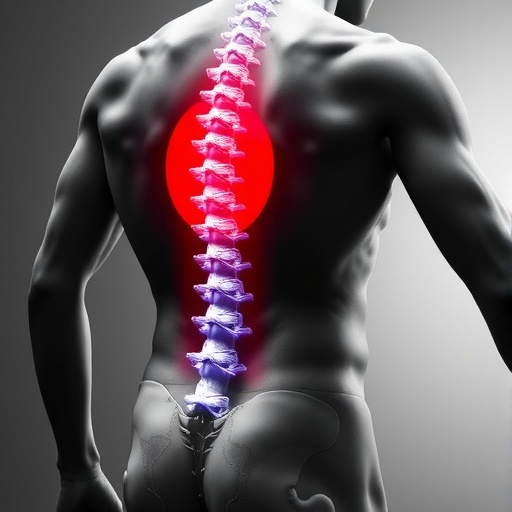In an innovative study spearheaded by researchers Zhang, B., Li, TC., and Wang, X., the impact of disc degeneration on the lumbar spine’s biomechanical response under vibrational loading conditions has been rigorously explored. This research, published in the Journal of Medical Biology Engineering, delves into an often-overlooked aspect of spine health that is exacerbated by both occupational and recreational activities resulting in spinal vibrations. The findings can potentially reshape how medical practitioners approach treatment and prevention strategies for spinal disorders.
Disc degeneration, a progressive condition characterized by the deterioration of intervertebral discs, poses significant risks for individuals, especially those engaged in physically demanding professions. The study notes that the integrity of these discs is crucial for maintaining not only spinal alignment but also resisting biomechanical stresses. Through advanced biomechanical modeling and experimental techniques, the researchers were able to quantify the changing responses of the lumbar spine as disc degeneration progresses, particularly under conditions of vibrational stress.
The use of vibrational loading conditions in the study underscores the relevance of real-world scenarios where individuals are often subjected to repeated jarring motions. For example, workers in construction or those operating heavy machinery frequently experience vibrations that can exacerbate disc degeneration. The research effectively highlights the potential for these vibrations to precipitate acute biomechanical failures in the lumbar spine, leading to conditions such as chronic back pain or even herniated discs, which significantly affect quality of life.
Employing state-of-the-art imaging and analysis techniques, the study meticulously examines how different degrees of disc degeneration alter the biomechanical characteristics of the lumbar spine. The intricacies of spinal biomechanics are profound, and this investigation offers critical insights into how degenerative changes can elevate risks during dynamic loading situations, which are critical considerations for both clinical assessments and rehabilitation protocols.
What sets this research apart is its multi-faceted approach combining theoretical models with empirical data derived from physical tests. By utilizing a spectrum of degenerative states observed in patients, the researchers developed a comprehensive understanding of how these conditions impact spine mechanics significantly. This not only contributes to academic knowledge but also has practical implications for the design of therapeutic interventions aimed at preserving spinal integrity under stress.
The implications of these insights cannot be overstated; with an aging population and more individuals partaking in vigorous physical activities, understanding the biomechanical response of the spine is crucial. When coupled with existing knowledge around lifestyle and occupational hazards, this research positions itself as a valuable asset for occupational health specialists and physiotherapists aiming to develop preventative strategies.
As disc degeneration affects millions globally, the findings highlight a gap in preventative care that needs addressing. Healthcare professionals may benefit from this research by adapting their treatment plans, using a more evidence-based approach grounded in the biomechanics of spinal health, particularly for populations at risk of vibrational loading. This study serves as a call to action for further exploration into preventative measures that can be implemented within highly dynamic work environments.
Moreover, the findings of this study have broader implications in the realm of ergonomics and workplace design. As industries evolve and incorporate modern machinery, understanding the biological limits of the spine will be fundamental in creating safer work environments. Workplaces could adapt to minimize vibrational exposure to employees, thus enhancing productivity and reducing the incidence of work-related spinal injuries.
The research not only broadens the scientific understanding of spinal biomechanics but also emphasizes the importance of early diagnosis and intervention in disc degeneration. This necessitates a collaborative approach among healthcare providers, researchers, and employers to ensure that the findings translate effectively into real-world applications.
Furthermore, there is an exciting potential pathway for future research to explore the relationship between rehabilitation protocols tailored to individuals based on their degree of disc degeneration. Incorporating findings from in-vivo studies could further refine treatment methodologies, leading to more personalized care for patients experiencing chronic pain or mobility issues related to spine health.
In essence, Zhang and colleagues have illuminated a previously obscured aspect of spinal health and its significance in the context of modern lifestyles. Their contributions may not only inform clinical practices but also inspire future researchers to delve deeper into the biomechanics of the human body under various loading conditions. As our understanding grows, the hope is that innovations in treatment and preventative measures will emerge, paving the way for improved outcomes for individuals suffering from disc degeneration.
In conclusion, the work conducted by Zhang, Li, and Wang enriches the existing literature on spinal health by linking biomechanical responses to practical, real-world scenarios experienced by many individuals. The implications of their findings are vast, promising to influence both clinical practices and workplace safety protocols, ultimately fostering a future where spinal health is prioritized and preserved.
In a world where ergonomics and biomechanical health are becoming progressively more relevant, this research is not just timely; it is essential. The preservation of spinal health in the face of disc degeneration represents a critical frontier in medical science, echoing the need for proactive measures now and in the future.
Subject of Research: The impact of disc degeneration on the biomechanical response of the lumbar spine under vibrational loading conditions.
Article Title: The Effect of Disc Degeneration on the Biomechanical Response of the Lumbar Spine under Vibration Loading Condition.
Article References:
Zhang, B., Li, TC., Wang, X. et al. The Effect of Disc Degeneration on the Biomechanical Response of the Lumbar Spine under Vibration Loading Condition.
J. Med. Biol. Eng. 45, 22–33 (2025). https://doi.org/10.1007/s40846-024-00921-4
Image Credits: AI Generated
DOI: https://doi.org/10.1007/s40846-024-00921-4
Keywords: Disc degeneration, lumbar spine, biomechanical response, vibration loading, spinal health, workplace ergonomics, chronic pain, rehabilitation protocols.




